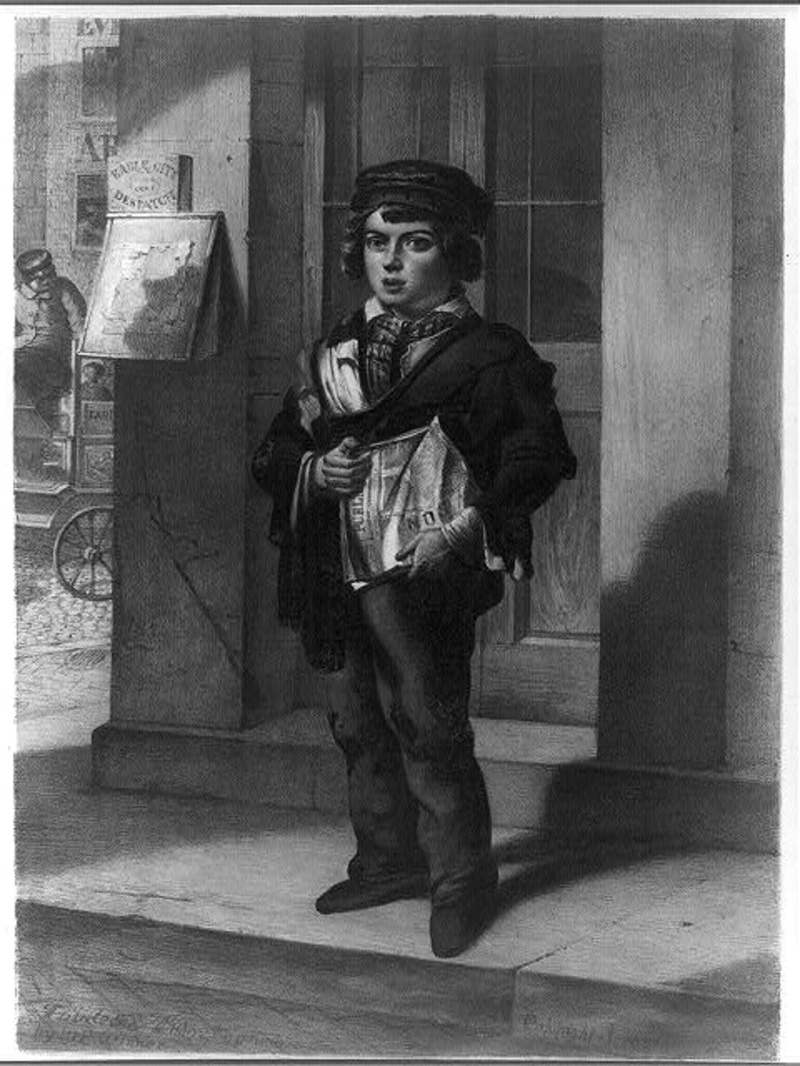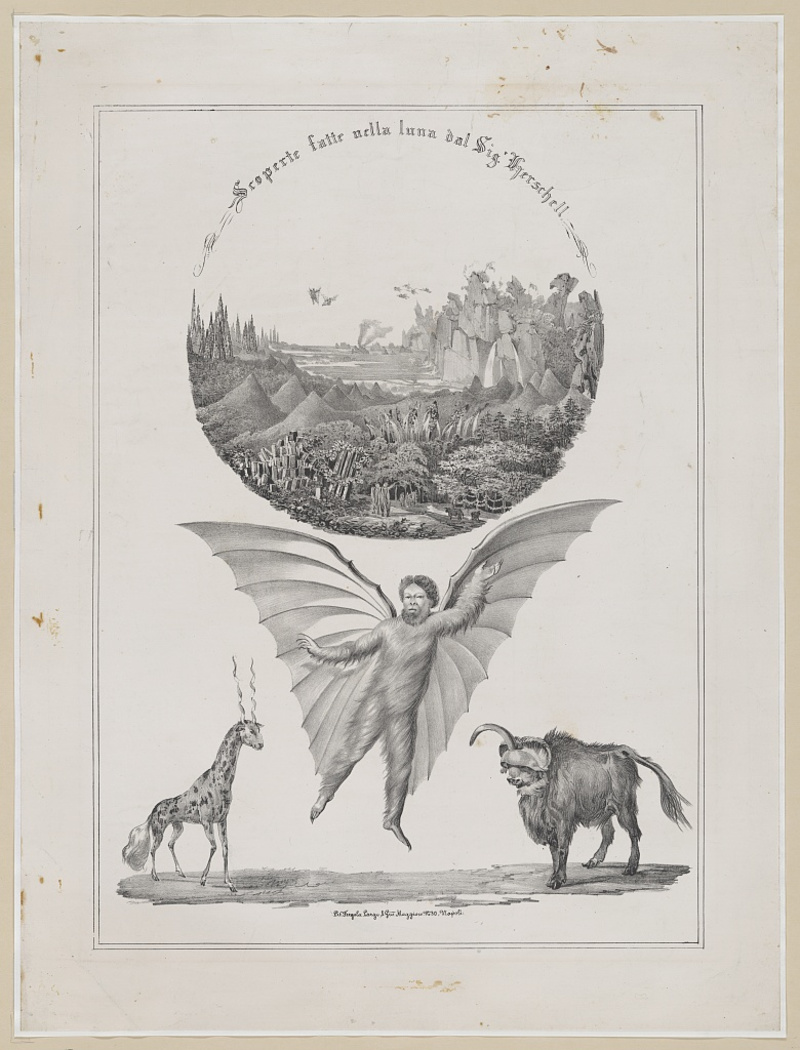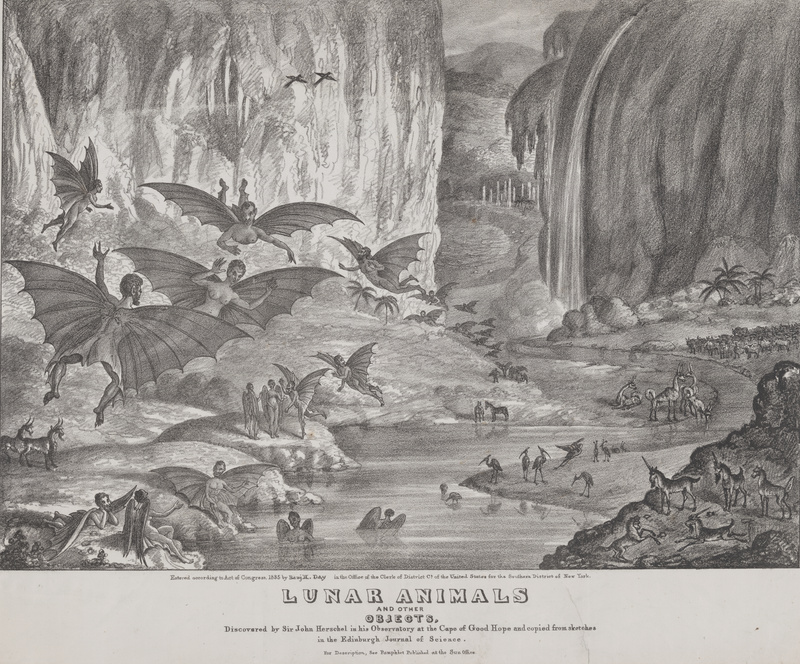Last Chance to Catch NYC's Holiday Notalgia Train
We met the voices of the NYC subway on our nostalgia ride this weekend!

In August 1835, The Sun newspaper made a shocking announcement: the discovery of life on the moon! Did New Yorkers believe it?

New Yorkers turned their attention skyward in the summer of 1835. Haley’s comet was on the way, and The Sun newspaper had just made a shocking announcement: a scientist had discovered life on the moon! This discovery, detailed over the course of six publications starting on August 21st, 1835, swept the city like wildfire (a literal fire came later that year…) and sent The Sun’s readership skyrocketing. It was one of the most sensational stories of the century and one that left a lasting impact on journalism.
The incredible story first appeared under the title “Great Astronomical Discoveries Lately Made by Sir John Herschel” (a real English astronomer). This initial article would have understandably been skipped over for more captivating stories of murder and crime that typically appealed to readers of the penny papers.
The Sun, New York’s first successful penny paper, debuted in September 1833. While most of the city’s newspapers at the time cost six cents, The Sun cost only one. As a result, it attracted a wider and more diverse audience of working-class New Yorkers. The content was also different. Founder Benjamin Henry Day filled his daily, four-page paper with local stories. Instead of covering foreign business affairs, The Sun published police court reports and stories of scandals and crime within New York City.
Due to the low cost of the paper, it needed to attract a large audience to be profitable. The sensational stories helped push large volumes of papers. Newsboys who hawked the papers in the street would skim the pages for the most enticing story to shout about over the sounds of the city’s busy streets.

By the time “Great Astronomical Discoveries” was published, The Sun was one of the most widely circulated papers in the nation. It also had a new editor, Richard Adams Locke, a writer from England who found success at The Sun with a series on the murder trial of a religious figure in upstate New York, Matthias the Prophet.
Intrigued by the natural sciences, Locke had been working stories of scientific discovery into the paper’s pages. The stories were inspired by discoveries he read about in various scientific journals. With Haley’s comet on the way, New Yorkers were more interested in celestial happenings in the summer of 1835 than they might have been at another time. In The Sun and The Moon: The Remarkable True Account of Hoaxers, Showmen, Dueling Journalists, and Lunar Man-Bats in Nineteenth-Century New York, author Matthew Goodman writes that Locke was inspired to write his Moon series after seeing an article entitled “The Moon and its Inhabitants” in the Edinburgh New Philosophical Journal.
In this piece, German astronomer Wilhelm Olbers stated his belief that the moon was covered in plant life and inhabited by rational creatures. Fellow astronomer Franz von Paula Gruithisen went a step further. He named the creatures Lunarians and argued that it was possible to communicate with them.
Another article Locke saw in that journal reported on a telescope invented by Thomas Dick, author of The Connection of Science and Philosophy with Religion. Dick believed that we could find life on the Moon if a group of scientists across the globe all trained their telescopes on the object for around-the-clock watch. Reading these incredible claims by respected figures in the scientific community, Locke began to wonder what the news coverage of such a discovery would be. And he set out to write it.
The Sun credited the “Celestial Discoveres” to the Supplement to the Edinburgh Journal of Science when the Moon series began on August 25th. Locke wrote that the information in the Journal had been provided by Dr. Andrew Grant, an assistant to astronomer Sir John Herschel. Grant had a front-row seat to the amazing discoveries Herschel made in his observatory at the Cape of Good Hope. Only, Grant wasn’t a real person.
The first installation promised readers that Herschel had “affirmatively settled the question whether this satellite (the Moon) be inhabited, and by what orders of being…and has solved or corrected nearly every leading problem of mathematical astronomy.” It then went on to describe in detail how Herschel’s new “hydro-oxygen telescope” worked.
The next day, The Sun reported on what the scientist saw through the telescope. As the telescope panned over the surface of the Moon, Grant claimed to have seen greenish-brown cliffs covered in a “dark red flower,” a lunar forest with trees “unlike any I have seen, except the largest kind of yews in the English churchyards,” a level green plain, “a mountainous district of a highly diversified and romantic character,” a large lake or inland sea, an area of “rugged and apparent volcanic character,” and “a lofty chain of obelisk-shaped, or very slender pyramids…of a faint lilac hue, and very resplendent.”

The first living creatures appear in Grant’s observation of a lush valley setting where “continuous herds of brown quadrupeds” are seen, “having all the external characteristics of the bison, but more diminutive than any species of the bos genus in our natural history.” In the same area, Grant observed a creature that would be “classed on earth as a monster. It was of a bluish lead color, about the size of a goat, with a head and beard like him, and a single horn, slightly inclined forward from the perpendicular.”
In the fourth installment of the Moon series, Grant wrote of “something worth looking at.” While exploring another valley scene, the telescope landed on “flocks of large winged creatures.” They stood upright like humans and were covered with “short and glossy copper-colored hair.” Their description continues as follows:
… and had wings composed of a thin membrane, without hair, lying snugly upon their backs, from the top of their shoulders to the calves of their legs. The face, which was of a yellowish flesh color, was a slight improvement upon that of the large orang outang, being more open and intelligent in its expression, and having a much greater expansion of forehead. The mouth, however, was very prominent, though somewhat relieved by a thick beard upon the lower jaw, and by lips far more human than those of any species of simia genus.
As these unbelievable claims were published, readers were enthralled. For those who missed earlier installments, Locke published a pamphlet of the series. Titled A Complete Account of the Late Discoveries in the Moon, it sold an estimated forty thousand copies. The pamphlet had no illustrations, but the first installment of the Moon series mentioned lithographs, so readers understandably wanted to see them. Locke had illustrations of the man-bats and lunar landscape drawn up. Lithographs titled Lunar Animals and Other Objects, Discovered by Sir John Herschel in His Observatory at the Cape of Good Hope and Copied from sketches in the Edinburgh Journal of Science sold for twenty-five cents.

The story was picked up by other papers around the country and around the world. It was translated into multiple languages, including Italian and French. The story also inspired the popular culture of the time. There was a play on the Bowery and a diorama at City Saloon on Broadway that recreated Herschel’s alleged discoveries. With the help of the Moon series, The Sun became the most popular newspaper in the world with a circulation of more than 19,000. How many readers took the Moon story as fact? A lot.
Using a foundation of real scientific theories and technologies of the time, Locke’s tale had just enough of a grasp on reality to convince the masses. However, not all bought in. Edgar Allan Poe saw the series as a ripoff of his own story published just two months earlier in the Southern Literary Messenger. The Unparalleled Adventure of One Hans Pfaall by Poe tells of an adventurer who takes a hot air balloon to the Moon and makes discoveries akin to those described in Locke’s story. James Gordon Bennett, editor of The Herald, called out the series as a hoax in his own paper, eliciting a response from Locke. Locke denied making the discoveries detailed in The Sun and refuted Bennett’s claims. By the end of the summer, however, newspapers that had initially republished the story were now calling it a hoax.
Locke and The Sun never directly and publicly admitted to making up the story. Locke wrote to Benjamin Day that every reader should “enjoy his own opinion,” and acknowledged that “many intelligent and scientific persons still believe it true, and will continue to do so to their lives’ end; whilst the skepticism of others would not be removed though they were in Dr. Herschel’s observatory itself.”
The Great Moon Hoax wasn’t the last “humbug” to hit New York. Edgar Allan Poe published his own hoax in The Sun in 1844 when he wrote of Thomas Monck Mason and his travels across the Atlantic in a hot air balloon. The Sun did eventually admit that the story was fake.
We are still plagued with “fake news” today. Conspiracy theories and images doctored by artificial intelligence make media literacy a crucial skill in deciphering what’s true and what’s false. Have you ever been duped by a news story?
Next, check out The Lost History of the Sun Clock and Thermometer
Subscribe to our newsletter